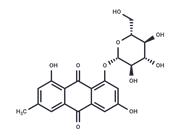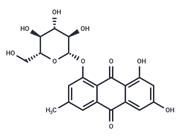| Name | Emodin |
| Description | Emodin (Frangula emodin) is an 11β-HSD1 inhibitor with a selective IC50 of 186 and 86 nM against 11β-HSD1 in humans and mice, respectively. Emodin has antiviral, anti-inflammatory, and anti-cancer effects. Emodin can improve metabolic disorders in diet-induced obese mice. |
| Cell Research | Emodin is prepared in DMSO and stored, and then diluted with appropriate medium before use[3]. The T24 human bladder cancer cells, the HCV-29 normal bladder epithelial cells and J82 human bladder cancer cells are are cultured in RPMI 1640 medium supplemented with 10 % fetal bovine serum at 37°C in a humidified atmosphere containing 5 % CO2. Cells are seeded in 96-well plates with 2×104 cells per well. The cells are incubated with Emodin for 24 h at different concentrations (0, 5, 10, 20, 30, 40, 50, 60, 70 μM) and chose the critical concentration (20 μM) treated with cells for 0, 6, 12, 24, 48, 72, 96 h. The cells are incubated with cisplatin for 24 h at different concentrations (0, 0.5, 1.0, 1.5, 2.0, 2.5, 3.0 μg/mL). MTT assay is used to analyze the cell viability. Cells are treated with drugs for 24 h and apoptotic rates are assessed with flow cytometry using AnnexinV-fluorescein isothiocyanate (AnnexinV-FITC)/propidium iodide (PI) kit. Samples are prepared according to the manufacturer's instruction and analyzed by a flow cytometry (FCM) Calibur[3]. |
| In vitro | METHODS: Human A375 cells were treated with Emodin for 24 hours, and MTT assay was used to detect the inhibition of cell growth.
RESULTS: Emodin inhibited the growth of A375 cells (IC50=44.91 μM). [1]
METHODS: Human A549 cells were treated with Emodin for 72 hours, and MTT assay was used to detect the inhibition of cell growth.
RESULTS: Emodin inhibited the growth of A549 cells (IC50=28 μM). [2]
METHODS: Mouse BALB/3T3 cells were treated with Emodin for 48 hours, and the cell growth inhibition was detected by Alamar blue assay.
RESULTS: Emodin inhibited the growth of BALB/3T3 cells (IC50=32 μM). [3] |
| In vivo | METHODS: To study the effect of Emodin on 11β-HSD1 activity in mice, Emodin (100 mg/kg, 200 mg/kg) was orally administered to normal C57BL/6J male mice.
RESULTS: Emodin inhibited the activity of 11β-HSD1 in normal C57BL/6J male mice. [4]
METHODS: To study the effect of Emodin on metabolism in obese mice, Emodin (100 mg/kg) was orally administered to obese mice twice a day.
RESULTS: Emodin improved insulin sensitivity and lipid metabolism in diet-induced obesity (DIO) mice, and decreased blood glucose and liver PEPCK and glucose-6-phosphatase mRNA. [4] |
| Storage | Powder: -20°C for 3 years | In solvent: -80°C for 1 year | Shipping with blue ice/Shipping at ambient temperature. |
| Solubility Information | Acetone : 7.14 mg/mL (26.42 mM), Sonication is recommended.
DMSO : 15.3 mg/mL (56.62 mM), Sonication is recommended.
H2O : < 1 mg/mL (insoluble or slightly soluble)
Ethanol : 3 mg/mL (11.1 mM), Sonication is recommended.
|
| Keywords | Spike | SARS-CoV | SARSCoV | SARS | resistance | insulin | Emodin | diabete | coronavirus | CK2 | CaseinKinase | Casein Kinase | casein | Autophagy | 11β-HSD1 |
| Inhibitors Related | Stavudine | Aceglutamide | Cysteamine hydrochloride | Sodium 4-phenylbutyrate | Hydroxychloroquine | Guanidine hydrochloride | Curcumin | Valproic Acid | Paeonol | Naringin | Alginic acid | Gefitinib |
| Related Compound Libraries | Traditional Chinese Medicine Monomer Library | Membrane Protein-targeted Compound Library | Selected Plant-Sourced Compound Library | Kinase Inhibitor Library | Anti-Viral Compound Library | Natural Product Library for HTS | Anti-Aging Compound Library | Anti-infective Natural Product Library | Immunology/Inflammation Compound Library | Anti-virus Traditional Chinese Medicine Monomer Library | Heat-Clearing and Detoxifying Traditional Chinese Medicine Compound Library | Anti-Cancer Active Compound Library |

 United States
United States






